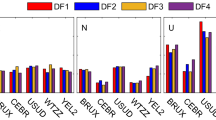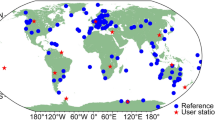Abstract
The third-generation BeiDou navigation satellite system (BDS-3) began providing global positioning, navigation and timing service on December 27, 2018. We present three triple-frequency carrier phase (CP) precise time and frequency transfer models using the BDS-3 B1I/B3I/B2a signals, named IF-PPP1, IF-PPP2 and UC-PPP models, respectively. The BDS B1I/B3I dual-frequency ionospheric-free (IF) model is also introduced, known as IF-PPP0 model. The corresponding mathematical and stochastic models are developed. Two stations located at time laboratories and connected to a high-precision atomic clock are utilized to assess the performances of the proposed CP precise time and frequency transfer models. In addition, the number of visible satellites, position dilution of precision, time dilution of precision, estimated positioning errors, zenith tropospheric delay and inter-frequency bias for two stations are also analyzed. The results show that BDS CP precise time and frequency transfer can achieve better performances with increasing number of BDS-3 observations. The proposed models all can be applied for precise time and frequency transfer with the BDS-3 triple-frequency signals, with stability and accuracy identical to the BDS IF-PPP0 solution. The stability of 10,000 s for the proposed BDS CP precise time and frequency models is better than 1.5 × 10−14.









Similar content being viewed by others
References
CSNO (2019) BeiDou navigation satellite system signal in space interface control document—open service signal B1I (Version 3.0). China Satellite Navigation Office, Beijing
Defraigne P, Baire Q (2011) Combining GPS and GLONASS for time and frequency transfer. Adv Space Res 47(2):265–275
Defraigne P, Aerts W, Pottiaux E (2015) Monitoring of UTC (k)’s using PPP and IGS real-time products. GPS Solut 19(1):165–172
Ge Y, Qin W, Cao X, Zhou F, Wang S, Yang X (2018) Consideration of GLONASS inter-frequency code biases in precise point positioning (PPP) international time transfer. Appl Sci 8(8):1254
Hopfield HS (1969) Two-quartic tropospheric refractivity profile for correcting satellite data. J Geophys Res 74(18):4487–4499
Jiang Z, Petit G (2004) Time transfer with GPS satellites all in view. In: Proceedings Asia-Pacific workshop on time and frequency 2004, p 236
Kouba J (2009) A guide to using International GNSS Service (IGS) products. IGS Central Bureau, Jet Propulsion Laboratory, Pasadena, CA, p 34
Landskron D, Böhm J (2018) VMF3/GPT3: refined discrete and empirical troposphere mapping functions. J Geod 92(4):349–360
Larson KM, Levine L (1999) Carrier-phase time transfer. IEEE Trans Ultrason Ferroelectr Freq Control 46(4):1001–1012
Leick A, Rapoport L, Tatarnikov D (2015) GPS satellite surveying, 4th edn. Wiley, Hoboken
Montenbruck O, Hugentobler U, Dach R, Steigenberger P, Hauschild A (2011) Apparent clock variations of the block IIF-1 (SVN62) GPS satellite. GPS Solut. https://doi.org/10.1007/s10291-011-0232-x
Montenbruck O, Hauschild A, Steigenberger P, Hugentobler U, Teunissen P, Nakamura S (2013) Initial assessment of the COMPASS/BeiDou-2 regional navigation satellite system. GPS Solut 17(2):211–222. https://doi.org/10.1007/s10291-012-0272-x
Petit G, Jiang Z (2007) GPS all in view time transfer for TAI computation. Metrologia 45(1):35
Petit G, Luzum B (2010) IERS conventions (2010). No. IERS-TN-36. Bureau International des Poids et Mesures Sevres (France)
Su K, Jin S (2018) Improvement of multi-GNSS precise point positioning performances with real meteorological data. J Navig 71(6):1363–1380
Su K, Jin S, Ge Y (2019a) Rapid displacement determination with a stand-alone multi-GNSS receiver: GPS, Beidou, GLONASS, and Galileo. GPS Solut 23(2):54
Su K, Jin S, Hoque MM (2019b) Evaluation of ionospheric delay effects on multi-GNSS positioning performance. Remote Sens 11(2):171. https://doi.org/10.3390/rs11020171
Tu R, Zhang P, Zhang R, Liu J, Lu X (2018) Modeling and performance analysis of precise time transfer based on BDS triple-frequency un-combined observations. J Geod 93(6):837–847
Wang N, Yuan Y, Li Z, Montenbruck O, Tan B (2016) Determination of differential code biases with multi-GNSS observations. J Geod 90(3):209–228
Wang K, Khodabandeh A, Teunissen P (2018) Five-frequency Galileo long-baseline ambiguity resolution with multipath mitigation. GPS Solut 22:75
Wang C, Zhao Q, Guo J, Liu J, Chen G (2019) The contribution of intersatellite links to BDS-3 orbit determination: Model refinement and comparisons. Navigation 66:83–97
Wu JT, Wu SC, Hajj GA, Bertiger WI, Lichten SM (1992) Effects of antenna orientation on GPS carrier phase. Astrodynamics 18:1647–1660 (Astrodynamics 1991)
Xiao W, Liu W, Sun G (2016) Modernization milestone: BeiDou M2-S initial signal analysis. GPS Solut 20(1):125–133
Xu G, Xu Y (2016) GPS: theory, algorithms and applications, 3rd edn. Springer, Berlin
Yang Y, Li J, Xu J et al (2011) Contribution of the COMPASS satellite navigation system to global PNT users. China Sci Bull 56(26):2813–2819
Yao J, Skakun I, Jiang Z, Levine J (2015) A detailed comparison of two continuous GPS carrier-phase time transfer techniques. Metrologia 52(5):666
Zaminpardaz S, Teunissen PJ, Nadarajah N (2017) GLONASS CDMA L3 ambiguity resolution and positioning. GPS Solut 21(2):535–549
Zhang P, Tu R, Gao Y, Liu N, Zhang R (2019) Improving Galileo’s carrier-phase time transfer based on prior constraint information. J Navig 72(1):121–139
Zhao Q, Wang C, Guo J, Wang B, Liu J (2018) Precise orbit and clock determination for BeiDou-3 experimental satellites with yaw attitude analysis. GPS Solut 22(1):4
Acknowledgments
This research is supported by the National Natural Science Foundation of China (NSFC) Project (Grant No. 41761134092), Jiangsu Province Distinguished Professor Project (Grant No. R2018T20), and Startup Foundation for Introducing Talent of NUIST (Grant No. 2243141801036). We thank the iGMAS for providing the BDS observation data and Wuhan University for providing precise orbit and clock products.
Author information
Authors and Affiliations
Corresponding author
Additional information
Publisher's Note
Springer Nature remains neutral with regard to jurisdictional claims in published maps and institutional affiliations.
Rights and permissions
About this article
Cite this article
Su, K., Jin, S. Triple-frequency carrier phase precise time and frequency transfer models for BDS-3. GPS Solut 23, 86 (2019). https://doi.org/10.1007/s10291-019-0879-2
Received:
Accepted:
Published:
DOI: https://doi.org/10.1007/s10291-019-0879-2




